

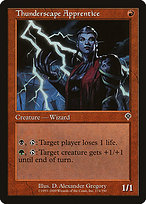








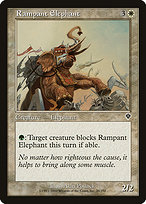
























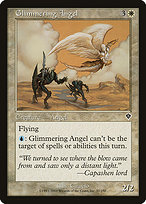























Invasion is a large set with 110 commons, 110 uncommons, 110 rares, and four variations of each standard basic land. This is the normal size for a large set of this era. Foil cards are included in booster packs with advertised odds of 1 : 100 cards. The set was printed in English in the USA. The existence of English Belgium-printed Invasion is unknown. [1]
Invasion was sold in 15 card booster packs. Booster boxes have 36 packs.
The US printing uses sequential collation with 10 × 11 sheets. Packs are back-facing with commons, then uncommons, and the rare last. If a foil card appears, it will appear at the end of a pack, but displace a card of the same rarity. Foil basic lands will also displace a common, (but basic lands otherwise do not appear in booster packs).
| 11 Commons | 3 Uncommons | 1 Rare |
Tournament packs have 30 basic lands, 3 rares, 10 uncommons, 32 commons (in this order). Observed decks are front-facing with lands followed by rares, uncommons, and commons. There is a survey insert and a rules insert splitting the commons roughly into two parts. (This is related to the common print runs as described below.) Packs have an outer seal, but no inner seal.
If a foil card appears, it will be between the basic lands and the rares, displacing a card of the same rarity. (Here, foil basic lands displace basic lands, not commons.) It may only be possible to get a single foil per pack (although this is hard to confirm).
| 30 Lands | 3 Rares | 10 Uncommons | 14 Commons | Survey Insert | Rules Insert | 18 Commons |
| 30 Lands | 3 Rares | 10 Uncommons | 16 Commons | Survey Insert | Rules Insert | 16 Commons |
There are four common runs. Two, A and B, have 30 cards (each twice) and two, C and D, have 25 cards (again, each twice). Each booster pack contains 6 commons from A and B followed by 5 from C and D. The A and B commons can be in A-B order or B-A order. Either way, the split will be either 3-3 or 4-2. (There is some evidence for a rate of 1/6 for 4-2 packs, but the data set is small, so this is far from certain.) The C and D commons can also be in either order independently of the ordering of A and B. Their split will be 2-3, 3-2, or 4-1. Most packs are 3-2. All four possible ordering appear 1/4 of the time (and all will appear in the same box). Foil commons displace an A or B card (probably whichever comes second in the pack). Foil basic lands displace a C or D card (probably whichever comes first in the pack).
In tournament packs, C and D commons appear before the inserts, and A and B commons appear after the inserts. The split will be either 14-18 or 16-16. In the C and D section, C cards will appear first and the split will be 7-7 (for 14) or 8-8 (for 16). The A and B commons can appear in either order, and the split will 9-9 (for 18) or 8-8 (for 16). In observed cases, a foil common displaces an A or B common (whichever is second).
Note that there is apparent symmetry between A and B commons, so the labels here are a little bit arbitrary. (C commons are distinct from D in that the apparently are always first in tournament packs. Possibly box collation can distinguish A and B, but this is not that compelling.)
Run A contains 30 cards each twice. Cards are in a repeating color pattern of black, white, red, blue, green. It is probably printed on the same sheet as either C or D. The choice of first card is mostly arbitrary.
 |  |  |  |  |  |  |  |  |  |
 |  |  |  |  |  |  |  |  |  |
 |  |  |  |  |  |  |  |  |  |
 |  |  |  |  |  |  |  |  |  |
 |  |  |  |  |  |  |  |  |  |
 |  |  |  |  |  |  |  |  |  |
Run B also contains 30 cards each twice. Cards are in a repeating color pattern of white, black, green, blue, red (with the common lands replacing certain cards). It is probably printed on the same sheet as either C or D. The choice of first card is mostly arbitrary.
 |  | 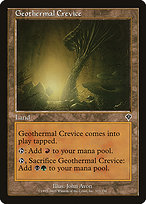 |  |  |  |  |  |  |  |
 |  |  |  |  | 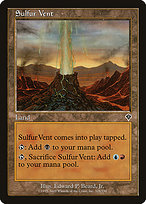 |  |  |  |  |
 |  | 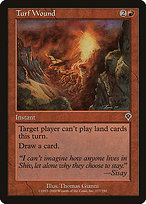 |  |  |  |  |  |  |  |
 |  | 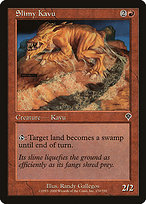 |  |  |  |  |  |  |  |
 |  |  |  |  |  |  |  |  |  |
 |  |  |  |  |  |  |  |  |  |
Run C contains 25 cards each twice. Cards are in a repeating color pattern of white, black, green, blue, red. It is probably printed on the same sheet as either A or B. The choice of first card is mostly arbitrary.
 |  |  |  |  |  |  |  |  |  |
 | 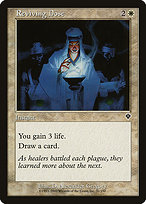 |  |  |  |  |  |  |  | 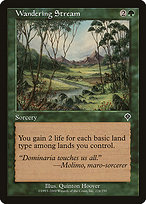 |
 |  |  |  |  |  |  |  |  |  |
 |  |  |  |  |  |  |  |  |  |
 |  |  |  |  |  |  |  |  |  |
Run D contains 25 cards each twice. Cards are in a repeating color pattern of white, black, green, blue, red (with the multicolored cards replacing certain cards). It is probably printed on the same sheet as either A or B. The choice of first card is mostly arbitrary.
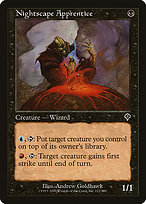 |  |  |  |  |  |  |  |  | 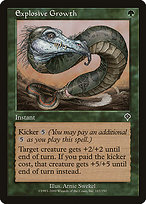 |
 |  |  |  |  |  |  |  |  |  |
 |  |  |  |  |  |  |  |  |  |
 |  |  |  |  |  |  |  |  |  |
 |  |  |  |  |  |  |  |  |  |
[1] The "Compilation of Manufacture Information for MTG Products" thread on the Magic Librarities Forum lists Belgian-printed English Invasion as uncertain. I also did not find any during my research.